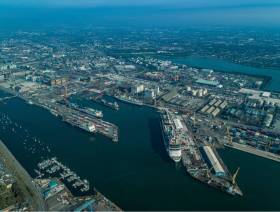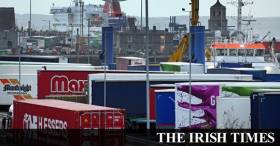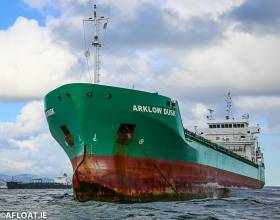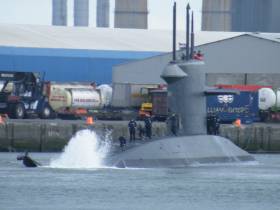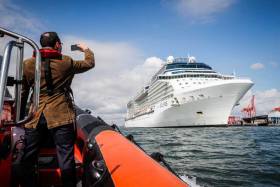Displaying items by tag: Dublin Port
Large Cruiseship Signals ‘End of an Era’ for Irish Cruise Tourism Following Dublin Port Cruise Ban
#cruiseliners - The arrival of thousands of well-travelled North American visitors on a huge cruiseship today could signal the ‘‘end of an era’’ due to actions of the Dublin Port Company, that's according to a group of businesses from across the tourism, retail and transport sectors.
The All-Ireland Cruise Ship Action Group (AICSAG) which was formed to campaign against the ban on cruiseships entering Dublin Port from 2021 has welcomed the influx of visitors due to the arrival of cruiseship Celebrity Reflection in the port today. (Afloat adds even larger capacity cruiseships have docked in the port previously).
Celebrity Reflection which holds 3,600 high-spending passengers from North America, is in Dublin for a ‘turnaround’, an industry term used when one group of passengers leave a cruise ship after a cruise and fly out of Ireland while another group of passengers jet into Dublin to join for a new cruise. Many of these high net worth individuals continue to spend time on the island of Ireland after their cruise ends.
According to AICSAG, turnarounds are believed to be worth up to €100 million to the Irish tourism industry but have now been banned by the Dublin Port Company.
Up until recently, the Dublin Port Company have been extremely active in promoting cruise tourism and were actively marketing to international cruise lines, such as Celebrity.
The decision by the Dublin Port Company to stop cruise ships docking at Dublin Port from 2021 was according to the Group taken without any consultations or engagement with the Minister for Transport, Tourism and Sport, local businesses, Dublin City Council, or the other Irish ports, namely Belfast, Waterford and Cork, who will be severely impacted by this decision.
Cruise companies market Ireland as a destination, and in addition to Dublin large cruise ships often stop off at Belfast, Waterford and Cork. Without access to Dublin Port, cruise companies will no longer stop in other Irish ports and will take hundreds of thousands of passengers out of Ireland to other European destinations.
Afloat.ie today contacted Dublin Port Company which issued the following statement in response to AICSAG.
The berth restrictions we are introducing in 2021 are intended to last three years (i.e. from 2021 to 2023) while we undertake major construction works on a 400 metre quay wall, Alexandra Quay West. (Afloat adds this quay forms part of Alexandra Basin).
As regards the long-term, we have planning permission to develop new berths suitable for cruise ships immediately east of the Tom Clark Bridge [East-Link] at an estimated cost of €100m. This is the subject of a cost benefit analysis study which is currently underway and which will be finished by mid-year.
We intend publishing this study as part of a public consultation process (including with the cruise industry) to ensure that a €100m investment by Dublin Port would be viable. Subject to the outcome of this process, the new berths would be constructed in 2024 / 2025 and be available in 2026.
In addition to the statement, DPC has supplied Afloat.ie with a Briefing Document for the Minister for Transport Shane Ross on Dublin Port’s new cruise ship berthing and pricing policy.
The detailed document published in March, covers many aspects including the Alexandra Basin Redevelopment Project (ABR) and as alluded above new cruise berths [at the North Wall Extension] available in 2026.
#ferries - The Port of Holyhead has shown “no sense of emergency” about Brexit, while Dublin Port bemoaned the huge expense preparing for a no-deal exit that might not happen, the British-Irish Parliamentary Assembly heard.
As The Irish Times writes at the biannual gathering of Irish and UK parliamentarians heard details of a report from one of its committees on a visit to the two Irish Sea ports by a delegation from the assembly to assess preparations for Brexit.
The committee painted a contrasting picture on preparations being taken in Dublin and Holyhead.
Darren Millar, a Conservative member of the Welsh national assembly, said that Dublin Port officials expressed concern about the number of customs officials that still needed to be hired to deal with a potential no-deal Brexit.
“Our biggest concern was that there was huge effort and huge expense going into these things and they may not be required,” he said on Tuesday, the second day of the assembly at Druids Glen in Co Wicklow.
Further reading on this story can be read through this link.
#cruiseliners - Shane Ross the Minister for Transport has sought to reassure DUP leader Arlene Foster that Cork and Belfast would fill the gap left by Dublin Port’s reduction in cruise ship arrivals.
As The Irish Times writes, Mr Ross wrote to the Northern Irish politician last month after she expressed concern that cruise liners may decide not to dock at Belfast Harbour if Dublin limited berth space for cruise ships due to construction work.
In his letter to Ms Foster, the Minister set out detailed conversations he had with the Dublin Port Company about its plans to reduce the number of cruise ships it can accommodate while it redevelops part of the port.
He told the DUP leader that while the port’s reduction in cruise business – from about 150 to 80 cruise ship arrivals a year from 2021 to 2023 – was “regrettable”, he welcomed the port’s intention to build cruise calls back to 150 ships in 2024 and 2025, rising to more than 200 arrivals after 2026.
For much more including comments from the politicians and a cruise campaign group click here.
#dublinbay- It was a busy scene in Dublin Bay during the May Bank Holiday as up to seven ships were at anchorage among them an Irish flagged cargo which stood out with its distinctive green painted hull, writes Jehan Ashmore.
The ship Arklow Dusk is the fourth and final of a quartet of 11,000dwt sisters acquired last year by Arklow Shipping following the bankruptcy of the Dutch based Flinter Group in 2016. The remaining sisters include Arklow Dawn, Dale and Day.
Acquisition of the former Flinter America and fleetmates as secondhand tonnage is unusual for ASL as the Co. Wicklow based company notably in recent years have taken delivery of newbuilds of various designs from Dutch and German shipyards.
Arklow Dusk had previously docked in Dublin Port after a voyage from Bilbao, Spain. On board was a cargo of cement products that were discharged alongside Ocean Pier. This was the first time the 132m double-hold cargoship made a call to the capital.
On completion of unloading, Arklow Dusk proceeded 'light' to Dublin Bay to anchor in the early hours of Thursday night. On the Bank Holiday Monday, the arrival of cruiseship Norwegian Pearl stood out and as the inaugural caller of the season to Dun Laoghaire Harbour.
The presence of these seven ships on Monday was short lived as by mid-morning Arklow Dusk having awaited orders departed. The 'D' class ship was bound again for Spain but this time to Carino located in north-west of the Iberian nation.
As Arklow Dusk set a southbound course along in the opposite direction came Schelde Highway from Zeebrugge, Belgium. The vehicle-carrier headed into the bay to occupy the same area where the Arklow-registered cargoship had taken up anchorage for more than four days.
Direct Shipping Routes to Europe on the Agenda as Flemish Government Visits Dublin Port
Delegates from the Flemish government visited Dublin Port Company to discuss the importance of direct shipping routes to Europe and preparations in the lead-up to Brexit.
Such preparations include the launch of the world’s largest roll on-roll off ship Celine and her sister ship MV Laureline who made her maiden voyage from Dublin Port last March.
#navalvisitors - One of the world's most sophisticated submarines and an accompanying support ship of the Royal Netherlands Navy arrived in Dublin Port yesterday for a three day crew rest and recreation visit, writes Jehan Ashmore.
This is not the first Dutch Navy visitor to the capital this year as HNLMS Van Speijk, a Karel Doorman-class frigate was part of a three EU member state flotilla that called last month.
On this current visit, the first to arrive in Dublin Bay was submarine HNLMS Zeeleeuw, which has a 2,650 tonnes displacement (when submerged). In advance of entering the port a tug along with a small craft assisted the diesel-electric powered submarine while off the South Burford Bouy.
HNLMS Zeeleeuw was commissioned in 1990 however the submarine unintentionally became the first of the 'Walrus' class as HNLMS Walrus was delayed for a long period following a serious fire during construction. The 68m submarine was built by Rotterdamsche Droogdok Maatschappij.
The Walrus class instead of using a cross-shaped assembly of stern diving planes and rudders, they mount four combined rudders and diving planes in an "X" tail configuration (as more clearly demonstated in related story photo).
In total there are four submarines in the class and the quartet play a pivotal role in operations given these submarines have stealth designed technology. Deployments include overseas patrols in the Caribbean Sea with calls to Williamstad, the capital of the Netherlands Antilles.
The second visitor to Dublin is HNLMS Mercuur, which is the only surface vessel designed specifically to support the operations of the Dutch Navy. The 64m vessel was built by Damen Schelde Naval Shipbuilding and entered service in 1987.
Both naval visitors are berthed downriver in the main part of the port having been allocated berths at Ocean Pier within Alexandra Basin. They will not be open to public tours.
The pair are scheduled to depart on Friday with an hour appart of each other exiting the port in the morning.
Cruise Passengers Numbers: Irish & UK Hits Record Two Million
#cruiseliners - Cruise passenger numbers from Ireland and the UK hit a record two million last year, figures from the Cruise Lines International Association show.
As the Irish Times reports the association bundles together Irish and UK numbers as most of the cruise itineraries take in both islands.
The Irish Travel Agents Association (ITAA) welcomed the record-breaking numbers, noting they signalled a 2 per cent year-on year-growth in passenger numbers.
“The cruise industry is demonstrating considerable growth, and has become an important part of both inbound and outbound Irish tourism,” said ITAA chief executive Pat Dawson.
“By hosting turnarounds Irish ports allow tourists to end their sailing here and travel within Ireland before flying directly home, while Irish holidaymakers join the ship to set sail on their adventure.”
Nonetheless Mr Dawson said it is disappointing that Dublin Port was reducing the number of cruise liners it will host.
Last year saw 150 ships call to Dublin Port and we expect this to rise to over 160 by the end of 2019.
For further reading on this story, click here to the newspaper.
Meeting with Minister Ross & Cruise Ireland Seen as 'Positive Step' for Irish Cruise Industry
Chairman of Irish Cruise Liner body Cruise Ireland, Mr Conor Mowlds said; “Cruise Ireland welcomed the positive meeting held with Shane Ross TD, Minister for Transport, Tourism and Sport, Brendan Griffin TD, Minister of State with responsibility for Tourism and Sport, government agencies and other commercial bodies involved in supporting Ireland’s Cruise Industry.
The meeting was called by Ministers Ross to discuss Dublin Port’s temporary move to reduce cruise vessel calls to the capital while it develops additional essential port infrastructure during the interim period of 2021-2024.
The meeting provided an opportunity for the relevant bodies to consider the options available to Ireland that would help to reduce the impact on the Irish Cruise Industry following Dublin Port’s strategic decision.
With this meeting and the recent attendance at the Global Cruise Seatrade Exhibition in Miami, Cruise Ireland is confident that positive measures are being taken to mitigate the temporary impact on the industry, and we are committed to supporting the future marketing and promotion of Ireland as a premier cruise destination.”
#cruiseliners - RTE news reports of efforts to be made to reduce any effect fewer cruise ships entering Dublin Port from 2021 will have on Dublin, it's retailers and ancillary businesses.
That's according to a spokesperson from Department of Transport Tourism and Sport, following a meeting between Ministers Shane Ross and Brendan Griffin, the tourism agencies and port chiefs.
Representatives from Fáilte Ireland, Tourism Ireland, Tourism Northern Ireland, the Port of Cork, Dublin Port, Shannon Foynes, the Galway harbour company, the Port of Waterford company and the Port of Belfast were in attendance.
The meeting discussed options that could be pursued to minimise disruption for the cruise industry and what, if any, other options there might be for the cruise industry around Ireland.
The spokesperson said the general consensus expressed was that the impact on the industry as a whole, across the island, should be modest but the impact could be acute on certain businesses.
More on the story can be read here.
Navies from EU Member States On Visit to Dublin Port
#navalvisitors - Navies from three EU member states have become the first foreign naval visitors of the year to call to Dublin Port having taken up berths since mid-week, writes Jehan Ashmore.
Over the previous two days, French, British and Dutch navies in that order have arrived to the capital and which has led to berths occupied at Ocean Pier, the marina at the Poolbeg Y&BC and at the North Quay Wall Extension. Next to the pier's Extension is the Tom Clarke (East-Link) bridge from where it should be possible to view all five visiting vessels.
As these naval vessels have occuppied berths within the more secure corden of the port's main estate located beyond the East-Link, they will not be open to public visits. Subsequent naval visitors, however may instead arrive to berth upriver along the Liffey Quays and hold public tours (or not as the case can be). Along this river bank is Sir John Rogersons Quay where such tours have been held and is convenient for the public to access given the close proximity of the capital's centre.
On this current call of naval visitors, the berth at Ocean Pier is where the French Navy's high-sea patrol vessel Premier maître l'Her is docked. The corvette is of the Estienne d'Orves class. Among its armoury is a SIMBAD anti-aircraft missile system. A sister Lieutenant de vaisseau Le Hénaff visited the port in 2017 but on that occasion headed upriver to berth along Sir John Rogersons Quay as pictured above.
Opposite of Ocean Pier on the south bank of the Liffey is the Poolbeg Marina, where the UK's Royal Navy presence consists of a trio of P2000 Archer class fast inshore patrol boats. The leadship of the class HMS Archer is joined by HMS Example and HMS Explorer.
These small craft provide training and maritime experience for University Royal Naval Unit students. In addition the URNU also provide support to wider Fleet tasking and exercises around the UK and Europe waters.
As for the waters of Dublin Port, the Royal Nederlands Navy is represented on this visit by HNLMS Van Speijk. This is the last ship of eight Karel Doorman-class multi-purpose frigates serving the Dutch navy and which was commissioned in 1995. Likewise of the French visitor, this frigate includes missiles in the form of the Sea Sparrow system.


























